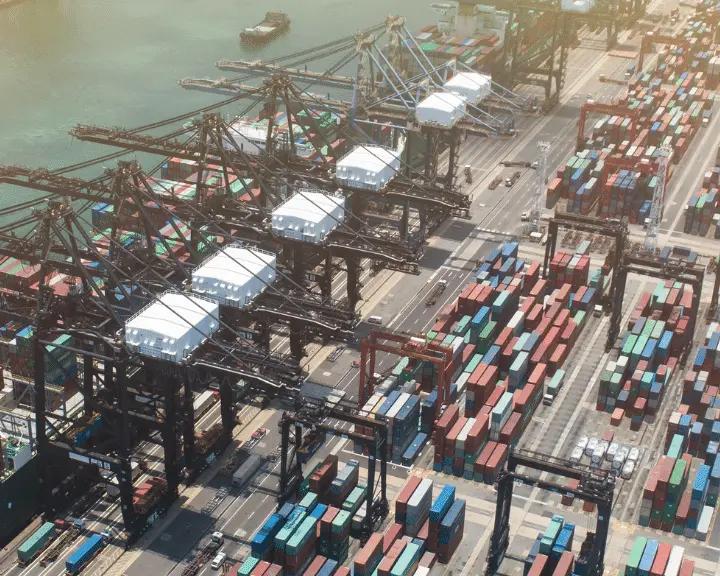New supply chain technlogy prepares your company for resilient growth at any pace, and helps you seize opportunities to scale your business, whether you’re processing ten transactions a day or 10 million.
Supply Chain Technology Trends
Even people outside of the supply chain and logistics industry have experienced minor hiccups or other disruptions within the supply chain in recent years. In this article, we’re going to examine some of the current supply chain technology trends, as well as what industry professionals, can expect in the future.
Supply chains have experienced increasing strain over the past few years thanks in part to the global Covid-19 pandemic but also as a result of socio-political developments around the world, like Russia’s invasion of Ukraine, the Suez Canal blockage of 2021, and numerous other contributing factors. 2022 has been the year of supply chain resilience. Other global trends affecting supply chains in 2022 were delays in production, overdependence on third parties, as well as labor shortages in some parts of the world.
Most production delays can likely be attributed to manufacturers jockeying for necessary commodities in short supply – this translates to sparse shelves in supermarkets, leading customers to experience more substantial purchase lead times. And while some markets have seen some job growth and recovery since the outbreak of the Covid-19 pandemic, numerous organizations are suffering from labor shortages for a variety of differing reasons. In some cases, there simply aren’t enough skilled individuals available to perform a job.
Because of the numerous supply chain disruptions from 2022 and years past, the future of supply chain will be driven by supply chain digitization and automation technology.
Supply Chain Technology Trends 2022
According to supply chain trends (2022 Gartner), some of the most prominent logistic trends 2022 and supply chain technology trends of 2022 include next-generation robotics, hyperautomation 2.0, security mesh, sustainability tools, ecosystem collaboration, and more.
Robot technology is advancing rapidly, and modern machinery is much more flexible, adaptive, and better suited to performing a variety of duties along the supply chain process. From more efficient warehouse pickers to driverless trucks and drone deliveries – robots are continually revolutionizing the supply chain industry. Hyperautomation 2.0 refers to an increased reliance on artificial intelligence and machine learning to help logistics entities with production initiatives, transport, warehousing, and more.
When considering supply chain statistics – 2022 has been a year of some tribulation as well as some growth. Gartner also reported that “Thirty-four percent of supply chain leaders say that adapting to new technology is the most important strategic change supply chain organizations will face” in the near future. These are the basic supply chain management trends of 2022.
Here are seven supply chain trends in the future to be watchful for include:
- Artificial intelligence & machine learning
- APIs
- Augmented Reality
- Predictive visibility
- Blockchain
- Canonical data
- Internet of Things
Supply Chain Technology Companies
Supply chains are sprawling networks comprised of hundreds of different companies and organizations all fulfilling a unique role. Within the umbrella term of supply chain technology companies, there are also digital supply chain technology companies, public supply chain software companies, supply chain SaaS companies, and even supply chain tech startups. Even the supply chain in IT industry plays a small part in a much larger, global collaboration effort.
The top supply chain management companies in the world understand the volatility of the global economy and the precariousness of various socio-political factors that contribute to the success of their daily operations.
Top supply chain software companies also understand that in order to thrive in such a challenging, competitive marketplace, companies must adapt quickly and implement more advanced technologies when it is practical and affordable to do so. Software like Chain.io allows for greater visibility into companies’ supply chain and logistics operations. When companies have better visibility of their daily operations, they can spend less time tracking down unknowns and more time growing the business and making improvements.
One of the biggest trends in supply chain technology in 2022 was the adoption of third-party supply chain visibility software by many logistics service providers. With this data, freight forwarders and their customers have more insights into the status of their shipments so they can better plan for disruptions or delays.
According to Gartner supply chain technology reviews, some of the top supply chain visibility companies are:
- FourKites: The real-time visibility software provider headquartered in Chicago supports customers in various industries, including retail, food and beverage, manufacturing, pharmaceuticals, and chemicals. The solution serves as a single source for visibility data, providing end-to-end visibility across the supply chain.
- Overhaul: As a supply chain control and risk management solution provider, Overhaul, which is headquartered in Austin, Texas, delivers a unified view of the supply in real-time. Its SaaS solution gives customers the ability to respond quickly to challenges in the supply chain ecosystem.
- project44: The visibility platform offered by project44 provides supply chain insights that include over-the-road, rail, air, ocean, and intermodal transportation modes, various workflows, and order and inventory.
- Terminal49: An all-in-one shipment and container tracking platform is helping shippers and forwarders streamline and automate their container tracking tasks to save hours of labor. Founded in 2015, the company has grown quickly offering complete container tracking through one API.
- Vizion API: VIZION API ensures shippers and BCOs can gain end-to-end visibility freight insights by providing automation that delivers comprehensive, standardized, and detailed container tracking events to software systems and spreadsheets.
What is Supply Chain Technology?
We’ve covered a few of the basics, but what is supply chain technology, exactly? Modern supply chain technology has come a long way in just the past few years. As we say goodbye to the supply chain technology trends of 2021, supply chain technology news shows companies trending heavily towards more and more automation initiatives.
Industry leaders understand the importance of technology in supply chain applications; information technology used in supply chain management can help streamline and optimize workflows, reduce the potential for human error or misplaced shipments, and can provide increased transparency and accountability within logistics applications.
Chain.io, for instance, can support businesses by integrating any system, from 1980s-era flat files to the latest APIs, enabling more efficient management of freight and shipment visibility, bookings, rate management, invoicing, and much more.
Supply chain technology can help improve multiple arenas across the industry – from shipping to trucking to all the logistics providers in between. Chain.io’s technology includes built-in connections to numerous leading software solutions for ease of integration into your customer’s digital systems, and you can obtain additional tools to supplement your current operations. And since it’s cloud-based, the whole platform is accessible around-the-clock and secure.
Supply Chain Technology Examples
Common technology supply chain issues can range from factory shutdowns to overwhelming demand. As supply chain technology continues to advance, companies are able to make more accurate predictions and better prepare for changes in demand. Additionally, technology can provide organizations with more efficient warehousing, improved shipping estimates and tracking, and more.
Supply chain technology examples (in addition to the ones mentioned previously) include cloud-based solutions and eCommerce networks, digital supply chain twins, as well as improvements in shipping and weighing technology. Cloud technology provides a wide array of benefits, from its accessibility to its relative security. Digital supply chain twins refer to a digitized recreation of supply chain systems as they exist in the real world – this allows for real-time information about the status of packages and deliveries to help organizations improve logistics. And advancements in weighing technologies provide a more efficient alternative to more traditional static weighing scales and improvements in products like onboard truck scales as well.
Supply chain technology news and supply chain technology trends have shown that more advancements will be made in automation technology in the coming years. Some of the most revolutionizing advancements have yet to arrive, however, so it’s difficult to know for certain which way the trends will steer the innovation within the supply chain technology industry.
Supply Chain and Logistics Technology Salary
There are innumerable employment opportunities (which you can browse on websites like LinkedIn) within the supply chain technology industry; companies need data analysts, product managers, solutions engineers, and more. The average supply chain and logistics technology salary can range between $50,000 and $130,000 based on various factors like local markets, level of experience, and the level of risk involved.
A supply chain technician's salary generally starts around $15-$19 per hour, according to [Salary.com|http://Salary.com], but ZipRecruiter claims the average annual pay for a supply chain tech in the United States is just over $80,000 per year (as of the time this post was written). As previously mentioned, one of the most substantial challenges facing the supply chain and logistics industry currently is a lack of skilled laborers to fill job openings. And companies that utilize technology the most efficiently will likely be the most appealing to prospective employees and recruits.
Technology in Supply Chain Management and Logistics
Supply chain technology companies like Chain.io fully understand the impact of technology on logistics and supply chain management. Technology in supply chain management and logistics: current practice and future applications all rely on the technology of some sort. Indeed, technology in logistics has been around since the industrial revolution and has steadily made advancements ever since.
Technology in supply chain management and logistics has advanced significantly in recent years, and industry experts generally agree that the upward trend is only going to continue for the foreseeable future. The role of technology in supply chain management is now inextricably linked to the longevity of the industry as a whole. Companies that discover how to utilize the latest technological advancements the best will become industry leaders as long as technology continues to advance.
The emerging technologies in logistics and supply chain management will continue to shape the industry as it evolves and continues undergoing a kind of digital transformation. New solutions and technology in supply chain management will help further develop information technology in supply chain management and help to make supply chain jobs safer for warehouse employees, and more efficient, and advancements and technology can also help reduce operational costs as well.







